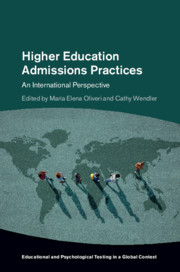Book contents
- Higher Education Admissions Practices
- Educational and Psychological Testing in a Global Context
- Higher Education Admissions Practices
- Copyright page
- Contents
- Figures
- Tables
- Contributors
- Series Editor’s Foreword
- Foreword
- Acknowledgments
- Part I Global Challenges and Common Admissions Models
- Chapter 1 An Overview of Higher Education Admissions Processes
- Chapter 2 Comparing College Aspirations across PISA Countries: Are 17 Percent Oranges Less than 75 Percent Apples?
- Chapter 3 Merit-Based Admissions in Higher Education
- Chapter 4 The Open Admissions Model: An Example from the United States
- Chapter 5 Character-Based Admissions Criteria in the United States and in Europe: Rationale, Evidence, and Some Critical Remarks
- Chapter 6 Cross-Cultural and Global Competencies and Their Role in Admissions Policies and Practices
- Part II Country-Specific Admissions Practices
- Part III Assessments Used in Higher Education Admissions
- Part IV Rethinking Higher Education Admissions
- Index
- References
Chapter 4 - The Open Admissions Model: An Example from the United States
from Part I - Global Challenges and Common Admissions Models
Published online by Cambridge University Press: 09 January 2020
- Higher Education Admissions Practices
- Educational and Psychological Testing in a Global Context
- Higher Education Admissions Practices
- Copyright page
- Contents
- Figures
- Tables
- Contributors
- Series Editor’s Foreword
- Foreword
- Acknowledgments
- Part I Global Challenges and Common Admissions Models
- Chapter 1 An Overview of Higher Education Admissions Processes
- Chapter 2 Comparing College Aspirations across PISA Countries: Are 17 Percent Oranges Less than 75 Percent Apples?
- Chapter 3 Merit-Based Admissions in Higher Education
- Chapter 4 The Open Admissions Model: An Example from the United States
- Chapter 5 Character-Based Admissions Criteria in the United States and in Europe: Rationale, Evidence, and Some Critical Remarks
- Chapter 6 Cross-Cultural and Global Competencies and Their Role in Admissions Policies and Practices
- Part II Country-Specific Admissions Practices
- Part III Assessments Used in Higher Education Admissions
- Part IV Rethinking Higher Education Admissions
- Index
- References
Summary
Open admission approaches offer a mechanism to reduce barriers for students whose backgrounds are disadvantaged or underprivileged. Institutions with open admissions provide higher education opportunities to many types of students including those who need or wish to reduce the costs of a more selective four-year institution, those who are seeking vocational or technical education, those who may need further academic preparation, and those who do not qualify for admissions to other, more competitive institutions. This chapter discusses the issues surrounding the open admissions model, including the benefits and challenges of implementing such a model. Avenues for future research and applications of an open admissions model are also discussed.
- Type
- Chapter
- Information
- Higher Education Admissions PracticesAn International Perspective, pp. 51 - 75Publisher: Cambridge University PressPrint publication year: 2020
References
- 1
- Cited by



